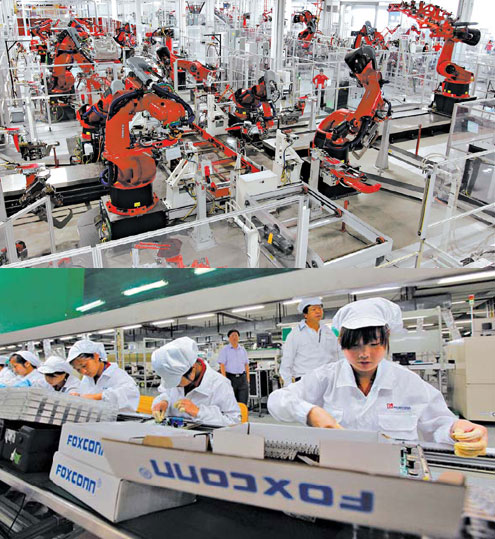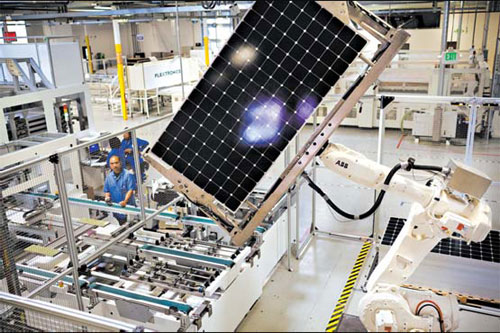Skilled work, without the worker
Updated: 2012-08-26 07:59
By John Markoff(
The New York Times
)
|
|||||||
|
New robots like those at a Tesla factory in California, above, are replacing workers. Foxconn plans to install more than a million robots within a few years in China. Paul Sakuma / Associated Press; below, Ym Yik / European Pressphoto Agency |
Nimble new robots change industry
Drachten, the Netherlands
At the Philips Electronics factory on the coast of China, hundreds of workers use their hands and specialized tools to assemble electric shavers. That is the old way.
At a sister factory here in the Dutch countryside, 128 robot arms do the same work with yoga-like flexibility. Video cameras guide them through feats well beyond the capability of the most dexterous human.
One robot arm endlessly forms three perfect bends in two connector wires and slips them into holes almost too small for the eye to see. The arms work so fast that they must be enclosed in glass cages to prevent the people supervising them from being injured. And they do it all without a coffee break - three shifts a day, 365 days a year.
All told, the factory here has several dozen workers per shift, about a tenth as many as the plant in the Chinese city of Zhuhai.
This is the future. A new wave of robots, far more adept than those now commonly used by automakers and other heavy manufacturers, are replacing workers around the world in both manufacturing and distribution. Factories like the one here in the Netherlands are a striking counterpoint to those used by Apple and other consumer electronics giants, which employ hundreds of thousands of low-skilled workers.
"With these machines, we can make any consumer device in the world," said Binne Visser, who manages the Philips assembly line in Drachten.
Many industry executives and technology experts say Philips's approach is gaining ground on Apple's. Even as Foxconn, Apple's iPhone manufacturer, continues to build new plants and hire thousands of additional workers to make smartphones, it plans to install more than a million robots within a few years to supplement its work force in China.
Foxconn has not said how many workers will be displaced. But its chairman, Terry Gou, has endorsed a growing use of robots. Speaking of his more than one million employees, he said in January, according to the official Xinhua news agency: "As human beings are also animals, to manage one million animals gives me a headache."
The falling costs and growing sophistication of robots have renewed a debate over how quickly jobs will be lost. This year, Erik Brynjolfsson and Andrew McAfee, economists at the Massachusetts Institute of Technology, made the case for a rapid transformation. "The pace and scale of this encroachment into human skills is relatively recent and has profound economic implications," they wrote in their book, "Race Against the Machine."
In their minds, the advent of low-cost automation foretells changes on the scale of the revolution in agricultural technology over the last century, when farming employment in the United States fell from 40 percent of the work force to about 2 percent.
But Bran Ferren, a veteran roboticist and industrial product designer at Applied Minds in Glendale, California, argues that there are still steep obstacles. "I had an early naivete about universal robots that could just do anything," he said. "You have to have people around anyway. And people are pretty good at figuring out, how do I wiggle the radiator in or slip the hose on? And these things are still hard for robots to do."
Beyond the technical challenges lies resistance from unionized workers and communities worried about jobs. Even though rising labor and transportation costs in Asia and fears of intellectual property theft are now bringing some work back to the West, the ascension of robots may mean fewer jobs will be created.
At the Flextronics solar panel factory in Milpitas, south of San Francisco, a banner proclaims, "Bringing Jobs & Manufacturing Back to California!" Yet in the plant, there are robots everywhere and few human workers. All of the heavy lifting and almost all of the precise work is done by robots. The human workers trim excess material, thread wires and screw in a handful of fasteners.
Such advances in manufacturing are also transforming other sectors that employ millions of workers. One is distribution, where robots that zoom at the speed of the world's fastest sprinters can store, retrieve and pack goods for shipment far more efficiently than people.
Rapid improvement in vision and touch technologies is putting a wide array of manual jobs within the abilities of robots. For example, Boeing's wide-body commercial jets are now riveted automatically by giant machines that move rapidly and precisely over the skin of the planes.
And at Earthbound Farms in California, four newly installed robot arms with customized suction cups swiftly place clamshell containers of organic lettuce into shipping boxes. Each robot replaces two to five workers at Earthbound.
A Robot Race Takes Shape
At an automation trade show last year in Chicago, Ron Potter, the director of robotics technology at an Atlanta consulting firm called Factory Automation Systems, offered an example of a robotic manufacturing system that initially cost $250,000 and replaced two machine operators, each earning $50,000 a year. Over the 15-year life of the system, the machines yielded $3.5 million in labor and productivity savings.
Government officials and industry executives in the United States argue that even if factories are automated, they still are a valuable source of jobs. If the United States does not compete for advanced manufacturing in industries like consumer electronics, it could lose product engineering and design as well. Moreover, even though blue-collar jobs will be lost, more efficient manufacturing will create skilled jobs in designing, operating and servicing the assembly lines.
And robot makers say their industry itself creates jobs. A report commissioned by the International Federation of Robotics last year found that 150,000 people are already employed by robotics manufacturers worldwide.
But American and European dominance in the next generation of manufacturing is uncertain. "What I see is that the Chinese are going to apply robots, too," said Frans van Houten, Philips's chief executive. "The window of opportunity to bring manufacturing back is before that happens."
A Faster Assembly Line
At Tesla Motors in Fremont, California, on the edge of Silicon Valley, as many as eight robots perform a ballet around each vehicle as it stops at each station along the production line for just five minutes. The robot arms seem human when they reach over to a stand and change their "hand" to perform a different task. While the many robots in auto factories typically perform only one function, a Tesla robot might do up to four: welding, riveting, bonding and installing a component. Ultimately as many as 83 Tesla S electric luxury sedans a day will be produced at the factory. When the company adds a sport utility vehicle next year, it will be built on the same assembly line, once the robots are reprogrammed.
Tesla's factory is tiny but represents a significant bet on flexible robots, one that could be a model for the industry. And others are already thinking bigger.
Hyundai and Beijing Motors recently completed a mammoth factory outside Beijing that can produce a million vehicles a year using more robots and fewer people than the big factories of their competitors and with the same flexibility as Tesla's, said Paul Chau, an American venture capitalist at WI Harper.
Humans' Changing Role
In the decade since he began working as a warehouseman in Tolleson, Arizona, Josh Graves has seen how automation systems can make work easier but also create new stress and insecurity. The giant facility where he works distributes dry goods for Kroger supermarkets.
Mr. Graves, 29, went to work in the warehouse right out of high school. The demanding job required lifting heavy boxes and the hours were long.
Today Mr. Graves drives a small forklift-like machine. He wears headsets and is instructed by a computerized voice on where to go in the warehouse to gather or store products. A centralized computer the workers call The Brain dictates their speed. Managers know exactly what the workers do, to the precise minute.
Because workers are doing less physical labor, there are fewer injuries, said Rome Aloise, a Teamsters vice president in Northern California. Because a computer sets the pace, the stress is now more psychological.
Several years ago, Mr. Graves's warehouse installed a German system that automatically stores and retrieves cases of food. That led to the elimination of 106 jobs, or 20 percent of the work force.
Now Kroger plans to build a highly automated warehouse in Tolleson.
"We don't have a problem with the machines coming," Mr. Graves told city officials. "But tell Kroger we don't want to lose these jobs in our city."
Some jobs are still beyond the reach of automation: construction jobs that require workers to move in unpredictable settings and perform different tasks that are not repetitive; assembly work that requires tactile feedback like placing fiberglass panels inside airplanes, boats or cars; and assembly jobs where only a limited quantity of products are made or where there are many versions of each product, requiring expensive reprogramming of robots.
But that list is growing shorter.
In an industrial neighborhood in Palo Alto, California, a robot armed with electronic "eyes" and a small scoop and suction cups repeatedly picks up boxes and drops them onto a conveyor belt.
The robot uses a technology pioneered in Microsoft's Kinect motion sensing system for its Xbox video game system.
Such robots will put automation within range of companies like Federal Express and United Parcel Service that now employ tens of thousands of workers doing such tasks.
The start-up behind the robot, Industrial Perception Inc. of Menlo Park, California, will win its first contract if its machine can move one box every four seconds. The engineers are confident that the robot will soon do much better than that, picking up and setting down one box per second.
"We're on the cusp of completely changing manufacturing and distribution," said Gary Bradski, a machine-vision scientist who is a founder of Industrial Perception. "I think it's not as singular an event, but it will ultimately have as big an impact as the Internet."
The New York Times
|
Robots at the Flextronics solar panel factory in Milpitas, California, do all the heavy lifting and almost all of the precise work, requiring little human help. Lianne Milton for The New York Times |
(China Daily 08/26/2012 page9)

